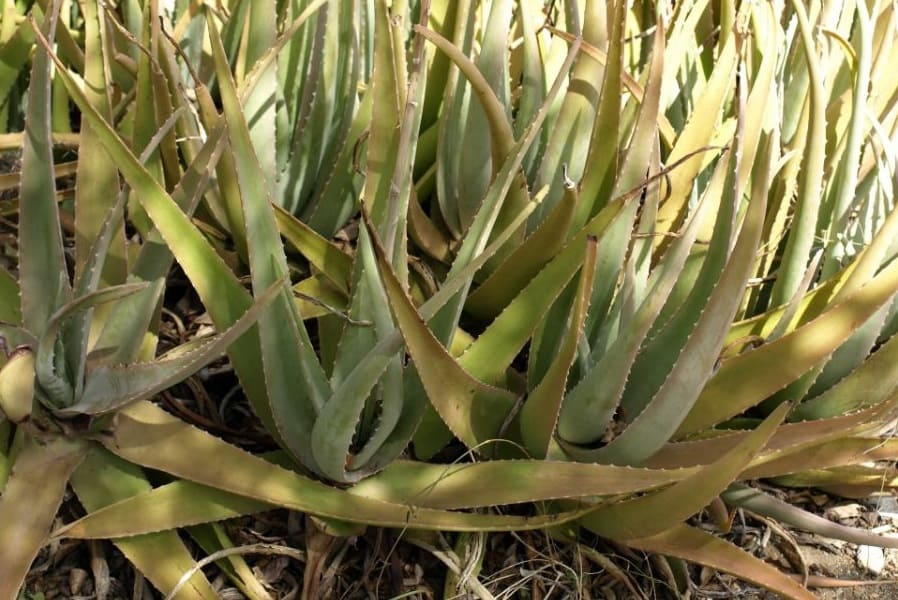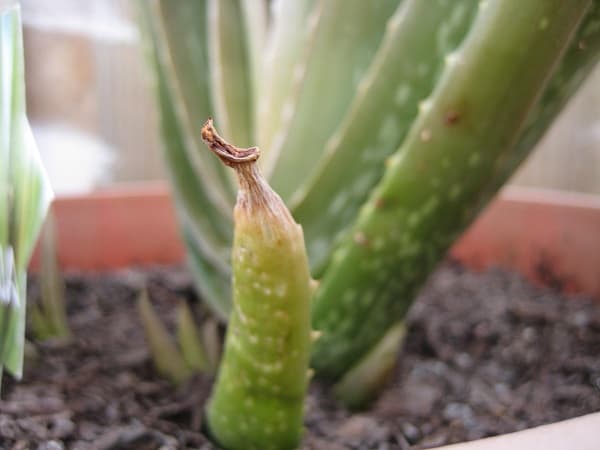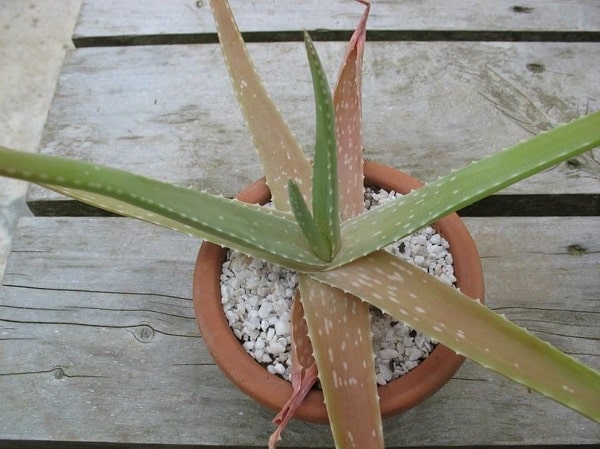Aloe Plant Browning: Unveiling the Reasons and Cures
Aloe vera is a plant that is treasured for its healing abilities and is quite famous as a houseplant. But it can be really frustrating when its leaves start turning brown out of the blue. Have you ever wondered why this happens? Well, wonder no more! In this article, we’re going to dive into the causes of this unpleasant browning issue and discover some simple ways to fix it. So, let’s get started and unravel the mystery together!

Why is My Aloe Plant Turning Brown?
You know, aloe vera is usually a tough plant that can handle almost anything. It’s an evergreen plant with chubby leaves in a neat circle, belonging to the succulent family. You can find lots of different types of aloe in tropical and subtropical areas. But here’s the thing: this cool plant, also called real aloe, can’t handle cold weather. That means it can only survive indoors or in a pot.


Now, sometimes you might notice brown spots on your aloe leaves, and that’s not good news. It’s like a signal that something is not right with your plant’s care. But don’t worry, we’ve got you covered! Let’s talk about eight possible reasons why your aloe plant is turning brown.
1. Pot is too small
First off, it could be that the pot you’re using is just too small. You see, aloe vera grows quite fast and forms baby aloe plants, which are called offsets. Eventually, they start spreading outside of the pot, and that’s when trouble begins. So, to help your aloe thrive, consider repotting it every two to three years.
2. Stress reaction after repotting
But wait, repotting can be stressful for a plant. Just imagine if someone took you out of your warm bed and put you in a new place. You’d need some time to get used to it, right? Well, the same goes for your aloe plant. It might show signs of stress, like brown leaves after being repotted. But don’t worry, it’s usually temporary, and your aloe will bounce back soon enough.
3. Waterlogging
Sometimes, though, it’s all about water. Aloe vera is a succulent, which means it can store water in its thick leaves and doesn’t mind a little dry spell. In its tropical home, these plants can take weeks without water. So, they’re not big fans of too much of it. If your aloe leaves turn mushy and brown, it could be a sign of waterlogged roots. Ah, we don’t want that!
To fix it, you need to act fast. Remove any dead or rotten leaves with a sharp knife, then carefully take the plant out of its pot. Check the roots for signs of rot and cut off any rotten parts. Let the cut parts dry for a few days, so they can heal. Mix some sand with the soil when you plant it again.
And here’s a pro tip: don’t water the aloe until the soil is completely dry. Give it just enough water to survive during its growing season, and protect it from severe dehydration during its winter nap. Above all, avoid waterlogging at all costs!
4. Dryness
If your aloe leaves still look nice and green, but the tips are dry and crispy, it might be because they’re a bit too dry. They just need a little more moisture, and voila! Your plant will bounce back quickly. But remember, when you water your aloe, make sure to pour the water at the roots, not all over the leaves or in the middle of the rosette. That’s the secret!
5. Too cold
Now, aloe vera is originally from Africa, and it loves warm weather. In fact, during the summer, you can even take your aloe plant outside as long as it’s in a pot. But here’s the thing: aloe vera doesn’t like low temperatures or frost at all. If it gets too cold, guess what happens? Yep, brown leaves. So, if you notice this happening, move your aloe to a warmer and more protected spot.
6. Too dark
Here’s a fun fact: aloe is a sun-loving plant! It needs sunlight to thrive and stay healthy. Even in the winter, when everything seems a bit gloomy, don’t forget to give your aloe a bright spot to soak up some rays. If they don’t get enough light, the leaves can turn brown.
7. Too much sun
While aloe vera loves a bright and sunny spot, be careful not to expose it to too much direct sunlight. When sunlight intensifies through a window pane, it can harm the plant. If you notice reddish-brown leaf surfaces or dry tips, it’s a sign of too much sun. In that case, move your aloe to a partially shaded area where it can still receive bright light but not direct sunlight.
By the way, did you know that young aloe plants are a bit more sensitive when it comes to sunlight? They need time to get used to it. So, if you just got a young aloe, slowly introduce it to a sunny spot instead of keeping it there all of a sudden. It’s like giving them time to build up their sun tolerance. Smart, right?
8. Nutrition deficiency
Lastly, aloe vera and its succulent friends can be quite picky eaters. They need the right nutrients to stay healthy and vibrant. Those brown spots on the leaves? Yeah, they could be a sign that your plant is lacking some important nutrients.
Don’t worry, though! When you repot your aloe every few years, it already helps provide a good supply of nutrients. And if you see those brown spots appearing, give your plant a boost with some succulent fertilizer. Just follow the instructions on the package, and your aloe will be one happy camper.
Can Brown Aloe Turn Green Again?
You must be wondering if your brown aloe can ever regain its green color. Well, good news! Yes, it can! Aloe vera has an incredible ability to rejuvenate itself when given the right conditions.
The process of turning brown aloe green again takes time and patience. So, don’t expect an instant transformation. But rest assured, if you’ve identified and fixed the underlying problems causing the browning, your aloe will begin to heal.
As your plant recovers, new growth will emerge from the center of the rosette, gradually replacing the brown leaves. Remember, at first, these new leaves might appear small and pale, but with proper care, they’ll develop into lush green foliage.
Here are a few tips to help your brown aloe make a successful comeback:
- Water wisely: Make sure the soil is well-drained and avoid overwatering. Allow the soil to dry out between waterings and water deeply but infrequently. Succulents like aloe prefer drier conditions rather than soggy roots.
- Give enough light: Find a bright spot for your aloe with moderate to high indirect light. Rotate the plant occasionally to ensure even growth and prevent leaning towards the light source.
- Provide optimal temperature: Aloe vera thrives in temperatures around 60-75°F (15-24°C) during the day and slightly cooler nights. Protect your plant from extreme temperature changes and drafts.
- Feed with care: While aloe plants don’t require frequent fertilization, using a balanced, diluted succulent fertilizer during the growing season can aid in their recovery. Follow the recommended dosage on the fertilizer package.
- Be patient and observant: Healing and rejuvenation take time, so keep a close eye on your aloe. Look for signs of improvement, such as new green growth and the gradual fading of brown discoloration. Celebrate each small victory!
Remember, each aloe plant is unique, and the time it takes to turn green again can vary. So, stay positive, provide the necessary TLC, and watch your aloe transform into a beautiful green beauty once more. Happy nurturing!
FAQs
Why are my aloe vera’s tips turning brown?
Those brown tips on your aloe vera can be a sign that something’s not quite right. Here’s the deal: there can be a few reasons behind it. One possibility is that you’re watering your aloe vera too much or too little. Yep, it’s tricky to find the right balance.
Another reason could be that it’s not getting enough humidity, like when the air is a bit too dry. Lastly, if your aloe vera is getting too much direct sunlight, especially when it’s super intense, those tip troubles might appear.
But don’t worry! By giving your aloe vera proper watering, ensuring it gets enough humidity, and finding a cozy spot with indirect sunlight, you’ll help it stay green and say goodbye to those brown tips. Keep an eye on its conditions, and you’ll have a happy, vibrant aloe vera in no time!
Why is my entire aloe vera plant turning brown?
Uh-oh! If your whole aloe vera plant is turning brown, it’s a sign that something bigger is going on. Let’s explore a few reasons why this might be happening and how you can fix it.
One possible cause is the temperature. Aloe vera plants love warmth, so if it’s getting too chilly or frosty where your plant is located, it can start browning all over. So, try moving it to a warmer spot and see if that helps.
Another thing to consider is sunlight. Aloe vera needs just the right amount of sunlight. If it’s not getting enough or if it’s getting too much direct sunlight, it can stress out and start browning. Find a place with a good balance of sunlight, not too strong and not too weak.
Now let’s talk about water. You know, too much water or poor drainage can cause the roots to get all soggy, leading to root rot. And guess what? That can turn your whole plant brown. Be sure to water your aloe vera in moderation and check that the soil drains well.
Lastly, nutrition matters too. Aloe vera plants need their essential minerals, just like we need our vitamins. If they don’t get the right nutrients or if there’s an imbalance in fertilizing, it can cause browning all over. So, make sure to feed your aloe vera with the appropriate plant food according to the instructions.
To get your aloe vera plant back to its vibrant green, you’ll need to figure out which factor is causing the browning and take action. It’s like being a plant detective! Adjust the temperature, find the right sunlight balance, water just enough, and provide proper nutrition. With a little love and care, your aloe vera can turn green and beautiful once again. Good luck!
